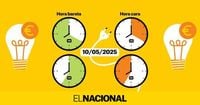The price of electricity in Spain has seen a dramatic drop on Saturday, May 10, 2025, averaging just 9.08 euros per megawatt hour (MWh), according to data from the Iberian Energy Market Operator (OMIE). This represents a staggering 50.2% decrease from the previous day's rate of 18.24 euros. Compared to the same day last year, electricity prices are down 68.6%, falling from 28.95 euros to the current rate.
The most notable aspect of today's pricing is the occurrence of negative rates during several hours, providing a unique opportunity for consumers to save on their electricity bills. The cheapest hour of electricity today is expected to be between 15:00 and 16:00, when the price drops to -10.00 euros/MWh, indicating that the cost of generation is effectively negative due to a surplus of supply. This is followed closely by other low-cost periods: from 14:00 to 15:00, the price is -7.50 euros/MWh, and from 13:00 to 14:00, it is -6.01 euros/MWh.
Conversely, the most expensive electricity will be available between 21:00 and 22:00, where the price spikes to 36.88 euros/MWh. Other high-cost slots include 22:00 to 23:00 at 31.46 euros/MWh and midnight to 01:00 at 29.22 euros/MWh. As such, consumers are advised to limit their use of high-energy appliances during these peak hours.
Throughout the day, the cheapest hours for electricity consumption are largely concentrated between 10:00 and 19:00, where prices range from -10.00 to 3.42 euros/MWh. This presents an excellent opportunity for households to schedule energy-intensive tasks, such as running dishwashers or washing machines, during these hours.
The new pricing structure introduced in 2024 has altered how the Voluntary Price for the Small Consumer (PVPC) is calculated. The new method incorporates a basket of medium and long-term prices to reduce volatility while still reflecting short-term market trends. As a result, the influence of the 'pool' price on the regulated tariff will gradually decrease, giving more weight to futures markets. By 2026, these markets will account for 55% of the pricing calculation.
For families looking to manage their electricity costs more effectively, understanding these price fluctuations is crucial. Experts recommend taking advantage of the negative pricing periods by running appliances during these times. For instance, keeping the air conditioning on for four hours a day at a rate of 0.30 euros per kWh could cost about 36 euros monthly if used during peak hours.
Other tips for reducing household electricity consumption include adjusting refrigerator thermostats to between 4 and 6 degrees Celsius, which can help save energy. Additionally, using the dishwasher on an economic program at 50ºC instead of 60ºC can yield savings of up to 20%. It's also advisable to wait until the dishwasher is full before running it, as the half-load setting does not significantly reduce energy use.
Spaniards spend an average of over three and a half hours daily in front of the television, which can account for up to 12% of total energy consumption. To mitigate this, experts suggest unplugging devices when not in use instead of leaving them in standby mode, as this can consume as much energy as when they are fully operational.
For cooking, it is recommended to avoid preheating the oven for long cooking times and to turn it off before the food is finished to utilize residual heat. Small appliances that generate heat, such as toasters and hair dryers, should also be used judiciously to avoid unnecessary energy waste.
In summary, the current electricity pricing trends in Spain demonstrate a significant opportunity for consumers to save on their energy bills by strategically planning their electricity usage. With prices dropping to unprecedented lows during certain hours, households can benefit by adjusting their routines to align with these favorable rates.
As the electricity market continues to evolve, consumers must stay informed about pricing changes and strategies to manage their energy consumption effectively. The current landscape presents a unique chance to not only save money but also contribute to more sustainable energy practices as Spain transitions towards a greener energy future.



